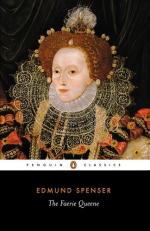252. UNTO HIM SELFE UNKNOWNE, i.e. being ignorant of his own wretchedness.
309. UNTHRIFTY SCATH, wicked damage, or mischief that thrives not.
313. THE SWELLING SPLENE. The spleen was the seat of anger.
314. SAINT FRAUNCES FIRE, St. Anthony’s fire, or erysipelas. Diseases were named from those who were supposed to be able to heal them.
335. WITH PLEASAUNCE, etc. Fed with enjoyment of the fields, the fresh air of which they went to breathe.
437. AND HELPLESSE HAP, etc. It does no good to bemoan unavoidable chance.
440. PAY HIS DEWTIES LAST, pay his last duty to the shade of the slain man by sacrificing his murderer.
443. ODDES OF ARMES, chances of mishap in arms due to some advantage of one’s antagonist.
QUESTIONS AND TOPICS
(Canto IV)
1. What are the moral reflections in stanza i? 2. What suggestion of the condition of the English roads do you find in st. ii? 3. But few returned, l. 21. What became of the rest? 4. Give a description of the House of Pride. Note resemblance to a typical Elizabethan hall. 5. Explain the allegory of the House, noting the association of ugliness and beauty. 6. How is expectation aroused in vi? 7. Describe the dramatic appearance and character of Pride. Cf. description of Satan on his throne in Paradise Lost, iii. 8. What do you learn in this canto of Elizabethan or chivalric manners and customs? 9. Describe the procession at the court of Pride. 10. What satire of the Romish priesthood in xviii-xx? 11. Note examples of Spenser’s humor in xiv and xvi. 12. Point out the classical influence (Dionysus and Silenus) in the description of Gluttony. 13. Subject of the interview between Duessa and Sansjoy. 14. Point out the archaisms in l. 10; alliteration in xxxix and l; the Latinisms in xlvi and xlvii. 15. In what case is way in l. 17? 16. Explain the meaning and historical significance of lazar, l. 24, and diall, l. 36. 17. Explain the references of the pronouns in l. 55, and ll. 418-419. 18. Note the Euphuistic balance and antithesis in xxix and xlv. 19. Explain the suffix in marchen in l. 325. 20. Note the double negative in iv, xlix. 21. Paraphrase in your own words ll. 239, 243, 360, 437.
CANTO V
I. The Plot: (a continuation of Canto IV). The Knight fights in the lists with Sansjoy and defeats him, but is prevented by Duessa’s magic from slaying him. Duessa descends to Erebus and obtains the aid of Night, who conveys the wounded Saracen in her chariot to Aesculapius to be healed of his wounds. The tortures of some of the souls in Erebus are described, particularly the cause of Aesculapius’ punishment. A roll of the prisoners whom the dwarf discovers in Pride’s dungeon is given. The Knight flees with the dwarf from her house.




